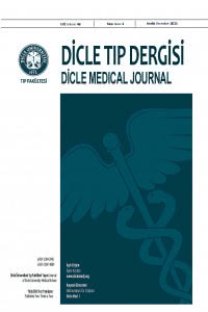Üst gastrointestinal sistem yabancı cisimleri
Foreign bodies in gastrointestinal tract
___
- 1. Smith MT, Wong RK. Esophageal foreign bodies: types and techniques for removal. Curr Treat Options Gastroenterol 2006;9:75-84.
- 2. Thomas W. Sadler Langmans Medical Embryology Lippincott Williams & Wilkins. 2006 10.Baskı, s112.
- 3. Kim SS, Kim JI, Kim SW, et al. Management of foreign bodies in the gastrointestinal tract: an analysis of 104 cases in children. Endoscopy 1999;31:302-304.
- 4. Rajagopal A, Martin J, Matthai J. Ingested needles in a 3-month-old infant. J Ped Surg 2001;36:1450-1451.
- 5. Akçalı Y, Yeşilkaya Y, Kahraman Cet al. Özafagus Yabancı Cisimleri. Erciyes Tıp Dergisi 1990;12:51-60.
- 6. Morrow SE, Bickler SW, Kennedy AP, et al. Balloon Extraction of Esophageal Foreign Bodies in Children. J Ped Surg 1998;33:266-270.
- 7. Calkins CS, Chirstians KK, Sell LL. Cost Analysis in the Management of Esophageal Coins: Endoscopy Versus Bougienage. J Ped Surg 1999;34:412-414.
- 8. Suita S, Ohgami H, Nagasaki A, Yakabe S. Management of pediatric patients who have swallowed foreign objects. Am Surg 1989; 55:585-590.
- 9. Arana A, Hauser B, Hachimi-Idrissi S, Vandenplas Y. Management of ingested foreign : review of the literature. Eur J Pediatr 2001;160:468-472.
- 10. Tokar B, Çevik AA, İlhan H. Ingested gastrointestinal foreign bodies : predisposing factors for complications in children having surgical or endoscopic removal. Ped Surg Int 2007;23:135-139.
- 11. Steven O I, Terry LJ, Michelle AA, et al. Management of ingested foreign bodies and food impactions. Gastrointest Endosc 2011;73:1085-1091
- 12. Kay M, Wyllie R.Pediatric foreign bodies and their management. Curr Gastroenterol Rep 2005;7:212-218.
- 13. Aqudah A, Daradkeh S, Abu-Khalf M. Esophageal foreign bodies. Eur J Cardio-thorac Surg1998;13:494-499.
- 14. Tünerir B, Dernek S, Uyguç Ö, ve ark.: Çocukluk Çağında Özefagusta En sık Görülen Yabancı Cisimler (Paralar) ve Tedavi Sonuçları. GKDC dergisi1998;5:354-358.
- 15. Akçalı Y, Yeşilkaya Y, Kahraman C, ve ark.: Özefagus Yabancı Cisimleri. Erciyes Tıp Dergisi,1990;12:51-60
- 16. Smith MT, Wong RK. Esophageal foreign bodies: types and techniques for removal. Curr Treat Options Gastroenterol 2006;9:75-84.
- ISSN: 1300-2945
- Yayın Aralığı: 4
- Başlangıç: 1963
- Yayıncı: Cahfer GÜLOĞLU
Our results of surgical treatment of supracondylar humeral fractures in children
Beşir DİKMEN, İbrahim Gökhan DUMAN, Raif ÖZDEN, Vedat URUÇ, Yunus DOĞRAMACI, Aydıner KALACI, Serhat KARAPINAR
Üst gastrointestinal sistem yabancı cisimleri olan çocuklarda fleksibl endoskopik işlem
Kaan DEMİRÖREN, Ahmet Cumhur DÜLGER, Şehmus ÖLMEZ, VELİ AVCİ, SALİM BİLİCİ, Mehmet MELEK, Halit PULAT
Primer enürezis nokturnalı çocuk ve ergen hastalarda oksidatif durumun değerlendirilmesi
Mahmut ABUHANDAN, Hasan KANDEMİR, Süleyman GETER1, İbrahim Fatih KARABABA
Comparison of botox and lateral internal sphincterotomy treatment outcomes in chronic anal fissures
Tolga DİNÇ, Bahadır EGE, Mehmet Fatih KARSLI, Faruk COŞKUN
ÖZHAN ÖZGÜR, Şeyda GÜNDÜZ, Metin ERKILIÇ, Hakan Şat BOZCUK
Mehtap BOZKURT, Cüneyt GOCMEZ, Mehmet OKÇU, Gül TÜRKÇÜ, Serda EM, PELİN OKTAYOĞLU, Demet UÇAR, Kemal NAS
Transrektal prostat iğne biyopsisi sonrası gelişen üriner sistem infeksiyonları deneyimlerimiz
Gülay DEDE, İrfan ŞENCAN, ONUR DEDE, Gönül ŞENTÜRK, Aslı HAYKIR
Eflatun YÜCEDAĞ, Ayhan UYSAL, Oktay BURMA, İbrahim Murat ÖZGÜLER, Mehmet Cengiz ÇOLAK, Tansel Ansal BALCI
Rafet METE, Murat AYDIN, Feti TULUBAŞ, Mustafa ORAN, Bünyamin Cüneyt TURAN, BİROL TOPÇU, Ahmet GÜREL, Hamit ATEŞ
Postmenopozal osteoporozlu hastalarda proteinler ve lipidlerdeki oksidatif stresin değerlendirilmesi
